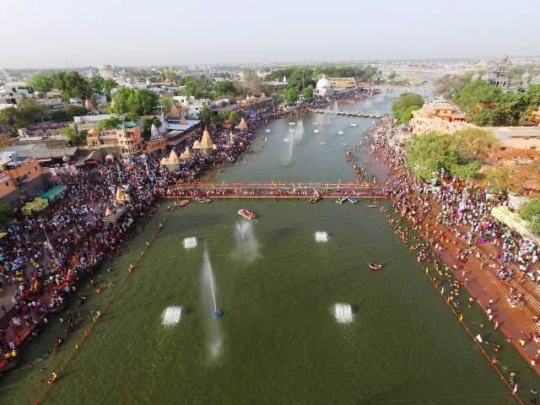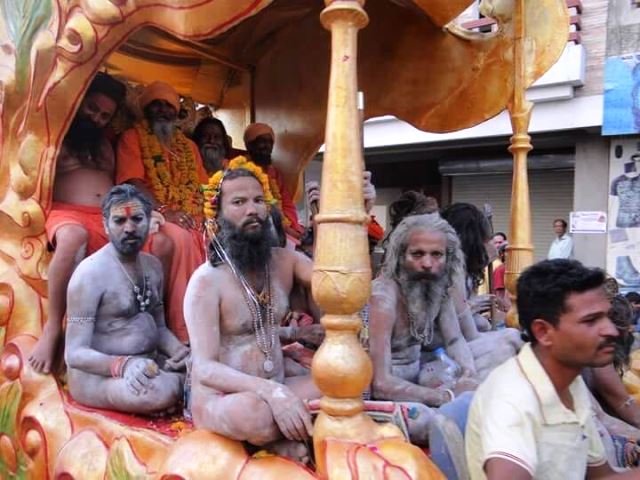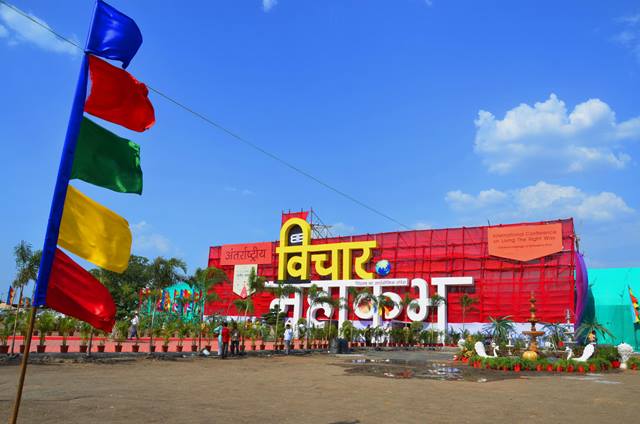Covering Simhasth Kumbh Mahaparv in Ujjain
Tips for journalist reporting on the largest spiritual gathering on the planet.

Over 4,000 journalists and media professionals from all over the world gathered in the ancient city of Ujjain, Madhya Pradesh, to cover Simhasth Kumbh Mahaparv. This vast Hindu festival takes place this year from April 22 to May 21 and attracts millions of devotees and guests from across the world to meet the saints, attend the Shahi Snaan (Royal Holy Dip) in the sacred river Kshipra and enjoy the inspiring messages conveyed in banners, formal talks and individual conversations.
Kumbh is more than a fair, a religious occasion and a symbol of Hindu tradition. Given the enormous scale of the event and its impact on the lives of millions of Indians, Kumbh affects the social and cultural values of a whole nation, affecting governments, policies, religions and cultural notions.
Hindu diversity in terms of traditions and beliefs, together with the tens of millions of people expected to attend the fair, make Kumbh a challenging event for any journalist, especially for the ones coming from outside India. What does it mean to cover the largest gathering in the globe? What are the main challenges journalists face in reporting on such an event? How can one reporter move through an event that covers more than 15 square miles (40 square kilometers), including 2,000 camps hosting saints and organizations’ representatives?
Covering Simhasth is tough, there is lack of orientation,
said senior journalist and associate editor of Telegraph Rasheed Kidwai. Those who are deep into religion and spirituality stay away from bytes and quotes. Access to the saints is never easy. Government, which is serving as a main interface for the event, has made no arrangements for structured interaction between the media and saints.
But, journalists who specialize in covering global religious movements can’t ignore this challenging event, Kidwai said. A visit to the holy bathing place Ramghat and other areas of Simhasth is a spirituality fulfilling experience. The faithful moving and undergoing all hardship with ease and smiles give insight into the world of faith and dharma.
Anup Dutt, covering the Kumbh for leading news website www.catchnews.com, said: The first challenge is to charge your biological clock. You have to get up very early, when the seers and their followers get ready to take a dip in the holy water or to offer a ritual. For interesting news stories, you need to mix with the seers or their associates.
An open, alert eye and ear is essential, Dutt said: Reporters covering Kumbh-like events have to cover much more than what a journalist usually covers inside a stadium. They have to focus on every single aspect: from religious preaching, speeches of seers on political and social development, to human rights—even genetic and digital sciences are discussed. You have to step outside your comfort zone and be on your toes. Journalists need to explore the essence of what is happening, rather than reporting only on the appearance of seers and sadhus—religious ascetics or holy persons. Journalists who report on that deeper level distinguish themselves from the masses of media people documenting such events.
To help journalists cover Kumbh, the organizers arranged dedicated areas with state-of-the-art facilities for print, web and TV journalists. We have eighteen media centers equipped with all the amenities to fulfill any kind of demand from media professionals,
said Devendra Joshi, PRO & Additional Director for Ujjain Kumbh. We accredited more than 4,000 journalists for the mega event; 756 international and national journalists applied for accreditation online.
The services we offer to the media include press conferences before every main event, such as royal baths and panchkoshi yatra, and daily updates by email. For the royal bath of 9th May, we arranged two police escort vehicles to smoothly ferry journalists to the bathing venue. Our Chief Minister has also invited many media teams to cover the Kumbh; we always prepare to give them passes even at the last moment.

Perhaps the most unusual aspect of Kumbh for journalists is the presence of holy men often called saints or seers or gurus in English, said Joshi. Kumbh has a strong presence of religious gurus and their organizations. Sometimes they may be feuding with each other.
Understanding the complex background of these religious movements is a challenge for journalists, if they do not gather background information before the event. Also, said Joshi, a journalist must know the history of Kumbh, akharas and the city, if he wants to be balanced and factual.
There are physical challenges as well, Joshi said. Due to summer and soaring temperature, journalist may face hard circumstances, but we have arranged dormitory, lunch, tea-coffee in our media centers.
Security is a big concern, as well. We only issue media-passes after proper scrutiny by the police superintendent. For many international journalists we applied the proper verification procedure to assure authenticity.
Veteran religion journalist and writer Jitu Sompura shared some advices as well: Anyone can do Kumbh reporting like the old story about one blind man describing an elephant by touching its trunk and another one holding its leg,
he said. But, if you want to report so that you are giving your audience a proper idea of the Hindu religion, then you should report on the traditions, meet nude saints, go to every akhara and meet their head Shri Mahant.
The sacred privacy surrounding many Hindu practices is another challenge for journalists. In Hindu tradition, many activities—such as the process of becoming naga saints and initiation in the akhara—are never carried out in public. These are essential elements in Hindu practice and the Kumbh is much more than a public fair—it is a sacred time and place for facilitating saints, for organizations to meet, for dialogue about the practice of the faith. One example is an emerging Meditation to Sanitation
campaign that will help to improve public health.
However, covering even the main public talks, dialogues and events is a challenge, because many of them take place simultaneously across the great breadth of the site.

Here are some final tips for journalists planning to cover a Kumbh fair
- Make sure to register as a media professional in advance. The event’s main website can help with registration and also has a great deal of helpful background information: http://www.simhasthujjain.in/
- There are well-equipped media centers at the fair, but remember there are areas in this enormous site where there is no internet access. Media professionals are respected in India and you can expect assistance and support in your work.
- While you are covering the fair, locate yourself in the area so you will fully catch the buzz of what is happening. Plan in advance to find a good location.
- Try to connect with a local colleague who can help you understand the complexity of the Kumbh as you move around the site.
- Wear comfortable shoes and plan to do a lot of walking. Exploring the variety of the Kumbh is best done on foot.
- Food is widely available, but ask in advance about food and water facilities. Carefully decide what you will eat and drink—as you could experience digestive problems.
- Veteran journalists know that we hear many different stories from the people we encounter. Remember that laymen may not accurately describe all of the traditions, customs and concepts. As always, look for experts to help you gain proper perspective.
- When encountering a nude saint, never touch the person. Many saints enjoy being photographed or filmed, but always politely ask permission before doing so.
- Prepare in advance to cover the bathing rituals! These are big, wet, crowded events involving people who are expressing great spiritual energy.
Useful links to cover Ujjain Simhastha Kumbh Fair
- Official website
- Facebook: simhasthujjain2016
- Instagram: simhasthujjain2016
- Twitter: @sunhasth
- Simhastha Kumbh Convention
- Humbh Area Map
- Aerial Shot of whle Kumbh
Read more on the Simhasth Kumbh Mahaparv
Bhavya Srivastava also has written on the event at the website of Read The Spirit: World’s largest peaceful gatherings are Hinduism’s sacred fairs called Khumbh Mela
Bhavya Srivastava is a veteran journalist specializing in religion news. For years, he has worked as a news writer and producer for a number of media companies, including the popular Indian network STAR News (now known as ABP News). His academic work includes sociology, political science, media ethics and post-graduate research in film production and electronic media. He is a member of IARJ.
